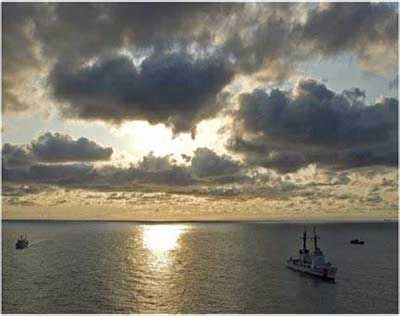Date: 14/03/2023
Relevance: GS-3: Economic Development, Biodiversity, and Environment.
Key Phrases: UN High Seas Treaty, Earth's habitable space, marine protected areas, climate mitigation, habitable space, climate mitigation.
Context:
- The UN High Seas Treaty, which will aim to protect 30 percent of international waters by 2030, was agreed recently in New York.
Key Highlights:
- The world's oceans cover 71% of our planet's surface and serve as the earth's largest carbon sink.
- They mitigate climate change by absorbing 93% of the heat trapped by greenhouse gases and around 30% of the CO2 emitted by burning fossil fuels.
- In addition, three billion people depend on its ecosystems for food and economic security.
- Less than 7% of the ocean is currently protected, and the high seas, which make up two-thirds of the world's ocean and 95% of the Earth's habitable space by volume, are largely lawless.
- The high seas accord, formally known as the Biodiversity Beyond National Jurisdiction treaty, classifies 30% of the world's oceans as protected areas.
- This agreement requires environmental impact assessments for emerging activities and ensures that benefits from the use of marine genetic material are shared.
- It also enables nations to set up marine protected areas (MPAs) in the high seas, which makes protecting 30% of land and sea by 2030 easier.
- MPAs can be effective in protecting marine life, as a 2017 study showed that marine reserves in national waters have on average 670% more fish, as measured by biomass, than adjacent unprotected areas.
- Flourishing populations of marine life in MPAs also spill over into fishing areas, providing fishermen with increased catches.
Why Protecting the High Seas Matters?
- The Ocean is BIG:
- The high seas refer to the part of the ocean that is beyond any country’s jurisdiction.
- Biodiversity:
- The high seas are among the last truly wild places on earth.
- They are home to bountiful marine biodiversity, including some of our most iconic and valued species.
- They support habitat and migratory routes that serve as “rest stops” for whales, sharks, sea turtles, and seabirds.
- They are also home to remarkable ecosystems, such as towering seamounts (think underwater mountains) and deep-water coral gardens.
- 30×30:
- Scientists tell us that it is critical to conserve or protect at least 30 percent of the ocean by 2030 (30×30) if we are to support healthy marine ecosystems and biodiversity globally.
- Although thousands of marine protected areas have been established around the world, they cover only a tiny percentage of the ocean.
- Currently, less than one percent of the high seas are in marine protected areas.
- Climate Change :
- Conserving the high seas through marine protected areas is not only good for biodiversity but also critical for our climate.
- The ocean plays an important role in regulating our climate — absorbing carbon dioxide and excess heat from the atmosphere, regulating temperatures, and driving our global weather patterns.
- Supporting the health of the ocean through marine conservation and the protection of blue carbon ecosystems helps ensure the ocean continues to serve its critical role in our climate system.
- Declining Whale Population:
- Unlike terrestrial animals, if a whale dies in the ocean, it pulls that carbon down to the depths, where it's stored.
- In addition, whales help increase phytoplankton activity through the "whale pump" process, where they dive down to feed and then return to the surface to breathe.
- Phytoplankton captures about 37 billion tonnes of CO2 a year and produces at least 50% of the oxygen in our atmosphere.
- Wherever whales go, phytoplankton blooms follow.
- Unfortunately, great whale populations have been diminished after decades of industrial whaling, reducing phytoplankton activity.
How can we protect and restore ocean biodiversity?
- Establishing protected areas: Setting aside areas of the ocean as marine protected areas can help protect vulnerable species and ecosystems from overfishing and other human activities.
- Reducing plastic waste: Reducing plastic waste can help prevent harm to marine species such as turtles and seabirds, which can become entangled in plastic or mistake it for food.
- Reducing greenhouse gas emissions: Reducing greenhouse gas emissions can help mitigate the impacts of climate change on the oceans, including rising temperatures and ocean acidification.
- Promoting sustainable fishing practices: Encouraging sustainable fishing practices, such as using fishing gear that minimizes bycatch.
Conclusion:
- The new Biodiversity Beyond National Jurisdiction treaty is a significant breakthrough in protecting the world's oceans and their biodiversity.
- The benefits of marine protected areas are not limited to biodiversity but also extend to climate mitigation, as healthy oceans play a crucial role in the carbon cycle.
- However, the implementation of the treaty will require continued dedication and focus from governments to ensure its success.
- It is crucial that protecting the high seas becomes a priority for nation-states in the coming decades to preserve the well-being of our planet and its ecosystems.
Source: Live Mint
Mains Question:
Q. Discuss the impact of human activities on the ocean's biodiversity and the steps that can be taken to protect and restore it. (150 Words).







